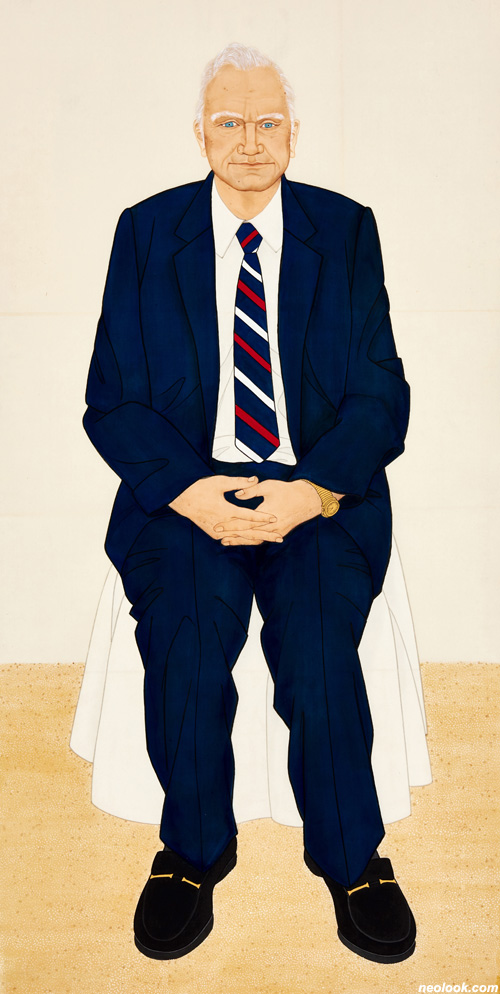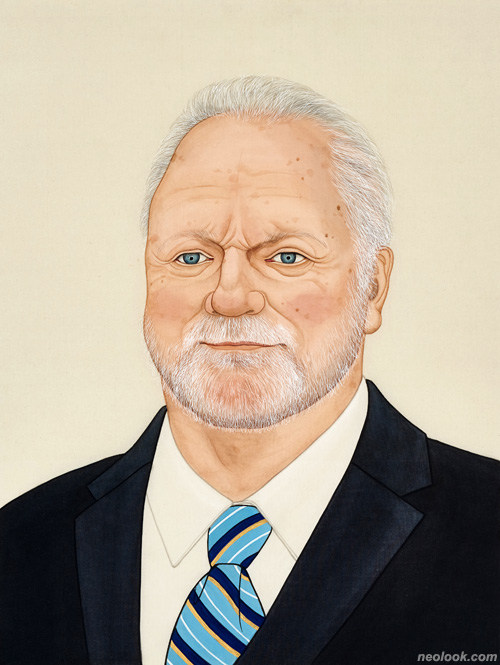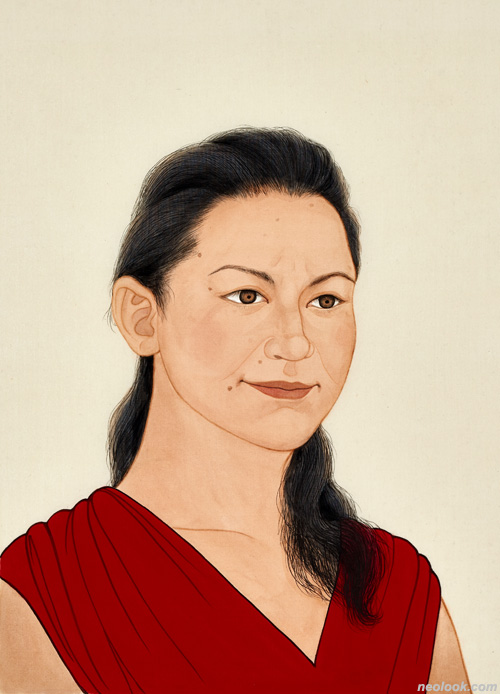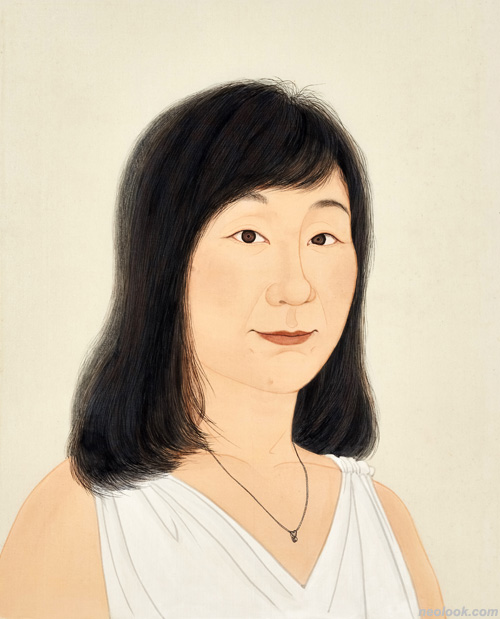- ● homepage
- ● archives
- ● restoration
- ● books
- ● big banners
- ● post board
- ■ neo's search
- ■ about us
- ■ 게재방법 안내
- 개인정보처리방침

- [email protected]
- Tel. 02_335_7922
- Fax. 02_335_7929
- 10:00am~04:30pm
- 월요일~금요일
- 3/3(월) 대체공휴일

플로리다 가계도 Family Tree Portraits
정두희展 / CHUNGDOOHEE / 鄭斗喜 / painting 2017_0616 ▶ 2017_0626

- 정두희_클레어런스 그로브즈 Clarence Groves_비단에 채색_160×80cm_2017
별도의 초대일시가 없습니다.
관람시간 / 11:00am~06:00pm
갤러리 한옥 GALLERY HANOK 서울 종로구 북촌로11길 4(가회동 30-10번지) Tel. +82.(0)2.3679.3424 galleryhanok.blog.me www.facebook.com/galleryHANOK
플로리다 가계도 ● 가계도 현존하는 조선시대 어진(御眞) 및 초상화 등의 복원모사본을 제작하면서 전통 회화에 대해 연구하고 있다. 조선의 초상화 제작 기법을 분석하면서 인물을 나타내는 독특한 표현법을 배워 가는 중이다. 어느 순간부터 그 표현법으로 주변 인물들을 해석하고 바라보기 시작했다. 외국인 남편 가족들과 오랜 시간을 같이 지내는 동안에도 그들의 모습을 전통 초상 기법으로 읽어내고 있었다. ● 2013년부터 2016년까지 미국 플로리다에서 체류하며 가족들의 초상화를 제작했다. 초상화의 주인공들은 클레어런스(Clarence)와 마지 그로브즈(Marge Groves) 부부, 여섯 명 자녀 중 테리(Terry)와 남편 존 컴버레지(John Cumberledge), 그들의 세 아들 부부, 마지막으로 반려견 코비(Kobe)와 덱스터(Dexter)이다. 가족의 일원으로서 바라 본 그들은 외조부모를 중심으로 강한 결속력을 가진 삼대 가족이다. 또한 서로 다른 지역, 나라의 문화에 기반을 둔 다문화 가족이다. 그 속에서 반려견 또한 가족 구성원으로 인정한다. 강력한 가족 공동체를 이루면서 각자의 개성과 인격을 존중하는 가족 구성원들을 ‘가계도’ 속 초상화로 담아내고자 했다. ● 전시에서 각 초상화는 개인의 특징과 성격을 드러내며, 전체 구성은 가계도의 구조를 나타내고 있다. 그리고 이 가족의 중심인 외조부모를 전신상으로 다시 담아내어 가족 구성원 내에서의 위상을 보여준다.

- 정두희_마지 그로브즈 Marge Groves_비단에 채색_160×80cm_2017

- 정두희_존 컴버레지 John Cumberledge_비단에 채색_43×33cm_2017

- 정두희_테리 컴버레지 Terry Cumberledge_비단에 채색_43×33cm_2017

- 정두희_매튜 컴버레지 Matthew Cumberledge_비단에 채색_43×33cm_2017
초상화 ● 왕의 초상을 일컫는 어진은 당대 최고의 화원들이 제작한 것으로 전통 초상 기법의 높은 수준을 짐작케 한다. 국립고궁박물관 소장 「태조(太祖)어진」, 「원종(元宗)어진」, 「영조(英祖)어진」, 「순종황제(純宗皇帝)어진」과 국립중앙박물관 소장 「고종(高宗)어진」의 복원모사본을 제작했다. 그리고 조선시대 공신도상과 사대부 초상들의 복원모사본을 제작하면서 조선시대 초상화가들이 대상의 정신을 담아내는 핍진(逼眞)함을 배우고자 했다. 이 과정에서 전통 초상의 특징을 구분하고 재료와 기법에 대한 연구를 심화할 수 있었다. ● 전통 초상화의 제작 과정은 밑그림이 되는 초본(草本) 과정, 비단에 선을 긋는 상초(上綃) 과정, 비단의 뒷면을 채색하는 배채(背彩) 과정, 비단의 앞면을 채색하는 전채(前彩) 과정으로 구분할 수 있다. 그 중 배채 과정은 투명한 비단의 특징을 효과적으로 사용한 기법이다. 전통 안료는 무기(無機) 안료와 유기(有機) 안료로 나눌 수 있다. 무기 안료는 광물성 석채(石彩)와 합성 무기물인 연백(鉛白) 등이 있다. 유기 안료는 연지(臙脂), 등황(橙黃), 쪽[남, 藍] 등이 있다. 조선 초상화 기법에서 공통적으로 보이는 얼굴의 배채는 대체로 연백에 무기 안료, 또는 유기 안료를 섞어 채색한다. 얼굴의 전채는 무기 안료인 주(朱)와 유기 안료 등을 사용한다. ● 이러한 전통 초상화 재료 기법을 바탕으로 ‘플로리다 가계도’ 전시의 초상화들을 제작했으나 전통 초상화와의 차이점들이 있다. 우선 다양한 인종의 인물들을 그려내고 있는 부분이다. 피부, 모발, 눈동자 등의 색이 다양하며, 이목구비(耳目口鼻)의 구조 또한 차이가 난다. 전통 초상 제작 기법을 활용하여 각 인물들의 외향적 특징을 묘사하고 나아가 그 인물의 성정(性情)까지 드러내고자 했다. 그리고 여성의 초상화를 함께 구성한 부분이 전통 초상화의 특징과 구분된다. 조선 초기에 제작된 여성 초상화는 대부분 남아 있지 않으며, 조선 중기 이후 유교적 사회 분위기 속에서 여성의 초상화를 거의 그리지 않았다. 이 전시에서는 가족 구성원인 여성들도 초상화의 주인공으로 등장한다.

- 정두희_미셸 컴버레지 Michelle Cumberledge_비단에 채색_43×33cm_2017

- 정두희_애론 컴버레지 Aaron Cumberledge_비단에 채색_43×33cm_2017

- 정두희_정두희 Doo Hee Chung_비단에 채색_43×33cm_2017
초상 제작 기법의 특징은 다음과 같다. 17세기 공신도상에서 바닥에 깔려 있는 중국산 카펫, 즉 채전(彩氈)은 다양한 색의 점묘로 이루어져 있다. 이번 전시의 전신상에서 실제 인물이 사용하고 있는 카펫은 황갈색의 점묘로 표현하였다. 조선시대 어진에서 금색 용보의 배면은 금박, 전면은 금분을 사용한다. 이번 전시의 초상화들에서는 손목시계, 안경 부분, 브로치, 신발 장식 등 소재를 달리 하여 그 기법을 응용했다. 전통 초상화 제작 기법에 바탕을 두면서 현재의 실제 대상을 드러내고자 변용한 부분들이다. ● 앞으로 전통 회화에 대한 지속적인 연구와 다양한 인물상을 새롭게 읽어나가는 것을 병행하고자 한다. 더 많은 수련과 고민을 거쳐 다음 인물들과의 만남을 이어갈 것이다. ■ 정두희

- 정두희_제시 컴버레지 Jesse Cumberledge_비단에 채색_43×33cm_2017

- 정두희_써머 컴버레지 Summer Cumberledge_비단에 채색_43×33cm_2017
Florida Family Tree ● Family Tree Portraits I have been studying Korean traditional paintings for more than twenty years, and have made many reproductions of royal portraiture from the Joseon dynasty (1392-1910). In analyzing the portrait techniques employed in the Joseon period, I found many unique characteristics and modes of expression. I have worked with and studied Joseon portraits so much that I find myself reinterpreting the faces of people around me. When I look at people, I often see them in the Joseon style in my mind’s eye. I even began to imagine non-Korean people as Korean traditional portraits. ● From 2013 to 2016, I lived in Florida, USA, creating portraits of my in-laws. The subjects featured in this exhibition are Clarence and Marge Groves along with their daughter Terry and her husband John Cumberledge, John and Terry’s three sons with their wives, and the family dogs Kobe and Dexter. As a part of this family, I was amazed at how close and connected everyone was, despite their being a multicultural family based on the cultures of different regions and countries. Even their dogs are recognized as family members. I wanted to represent all these family members who respect each other. ● In this exhibition, each portrait reveals the character and personality of the individual, and the complete installation reveals their family tree. Korean Traditional Portraits ● The Korean traditional royal portraiture was made by the greatest painters of the time and displays traditional painting techniques at their highest level. I have made reproductions of portraits of the Kings Taejo, Wonjong, Yeongjo, and Sunjong (owned by the National Palace Museum of Korea), as well as a portrait of King Gojong (owned by the National Museum of Korea). I tried to learn more about the virtues of the Joseon portraits by reproducing them. Through this process, I was able to fully understand the features of traditional portraiture, and I performed extensive research about its materials and techniques. ● The process of making traditional portraits begins with a sketching process in which the subject is sketched onto paper. This is followed by a tracing process in which one paints the image on a silk canvas with ink. Next are two stages of coloring, first the back of the silk canvas is colored, followed by the front. The coloring of the back side of the portrait is important, because the silk canvas is partially transparent, which allows the color to show through. ● Coloring is done with traditional pigments that can be divided into two categories: inorganic and organic. Inorganic pigments are mineral stones and white lead (which is a synthetic mineral), etc. Organic pigments are carmine, gamboge and indigo, etc. Although there are many variations in the use of pigments, there are some common conventions. For example, the back of the face is always painted in white lead mixed with either inorganic pigments or organic pigments, while the front of the face is painted with layers of cinnabar (an inorganic pigment) along with layers of organic pigments. ● Although the portraits in the Florida Family Tree exhibition borrow many features from Joseon dynasty portraiture, there are several differences between the portraits in this exhibition and traditional Korean portraits. First, the exhibition features portraits of non-Korean people. The colors of the skin, hair, eyes, etc. are more varied and the structures and shapes of the faces also differ. Second, there are many portraits of women in the exhibition. Few portraits of women made in the early Joseon period have survived, and in the mid-Joseon dynasty, women were rarely painted due to the cultural influence of Confucianism. In this exhibition, there are an equal number of women and men, and the women have the right side—rather than the traditional left side—of their faces depicted, so that each couple is facing each other. ● Some traditional techniques have been used in new ways to depict more modern objects. For example, in the portraits from the 17th century, Chinese rugs are depicted by colored dots. In the portraits of Clarence and Marge Groves, the actual carpet in their home has been represented by similar dots. In the Joseon Dynasty, golden objects were depicted by applying gold leaf to the back of the canvas and gold powder to the front. In my portraits, I applied this same technique to modern items such as watches, glasses, brooches, and shoes. These are just a couple of the ways that I used traditional portraiture techniques to depict objects of the present. ● I would like to keep studying traditional paintings and painting various subjects from my own point of view. Every person I meet is a potential subject, and I will keep refining my techniques and style with each new portrait. ■ Doo Hee Chung
Vol.20170616a | 정두희展 / CHUNGDOOHEE / 鄭斗喜 / painting
